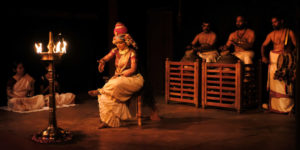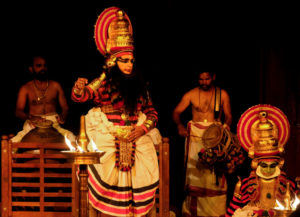A photo-essay on Kutiyattam’s art of storytelling through the eyes.
S. Harikrishnan

Kutiyattam is the ancient tradition of Sanskrit drama performed either with multiple actors on-stage or as solo performances—Nangiar Koothu (female performers) and Chakyar Koothu (male performers). Once considered a dwindling art form, the discovery of second-century playwright Bhasa’s palm-leaf manuscripts in the early 20th century led to the revival of Kutiyattam and more importantly, challenged the long-held assumption that Sanskrit drama was purely a literary form. Over the 20th century, the tradition grew from within the four walls of the temples into Kerala’s rich cultural public sphere. In 2001, UNESCO recognised the art-form, declaring it a ‘Masterpiece of the Oral and Intangible Heritage of Humanity’. Today, Kutiyattam survives as the oldest and only surviving form of traditional Sanskrit theatre in Kerala, and training centres like Natanakairali continue to expand the horizons of the art-form to beyond regional boundaries.
The emphasis on nethrabhinaya (the use of the eyes in acting) and rasavayu (the use of breath in evoking emotion) form an essential part of a performance, leading to Kutiyattam sometimes being referred to as the ‘theatre of the eyes’. Here, the performer embodies that which is being acted but also entices the spectators to use their own imagination—their own ‘realities’ of the scene—thereby converting them into (passive) performers. “Eyescapes”, as Madhavan (2012) calls this, helps Kutiyattam occupy a “liminal space between the ‘real’ and the ‘unreal’”. It is this that makes scenes like the portrayal of the elephants trying to catch moonbeams from Rasakreeda so graceful and natural; inviting the viewer to recreate the scene in one’s own mind.

This series focuses on the expressive nature of the art—the production and reception of an absent (landscape, act, temporality) present within the minds of the spectators mediated through the eyes of both the actor and the spectator. The pictures seen here were captured by the author during three different performances at Natanakairali between July 2018 and January 2019:
- Urubhangam (Kutiyattam), performed by Sooraj Nambiar (as Duryodhana), Ranjith Chakyar (as Balarama), Kapila Venu (as Gandhari) and Rajaneesh Chakyar (as Aswathama)
- Chitrangadha Charitham performed by Kapila Venu, is the Nangiar Koothu adaptation of Tagore’s one-act play Chitra. It tells the story of Chitra, the warrior princess of the Kingdom of Manipur.
- Rasakreeda (Nangiar Koothu), performed by Kalamandalam Sangeetha
Short clips from these performances can be seen here.
References:
- Madhavan, Arya. “Eyescape: Aesthetics of “Seeing” in Kudiyattam”, Asian Theatre Journal 29, no. 2 (2012): 567-568












Greetings
Beautiful learning material on this little known ancient art.
Crisp Nice pic in short with words depicted to elaborate.
Prayers
DrTPS
Very well described !
Good crisp piece of work and amazing pictures.
Informative
I was enchanted by the nethrabhinaya I saw in Nangyarkuth at Vyloppilli bhavan, TVM a few years back. I still wonder how the eyes of the artist are kept red.
Well done Hari
Very well written and photographed.